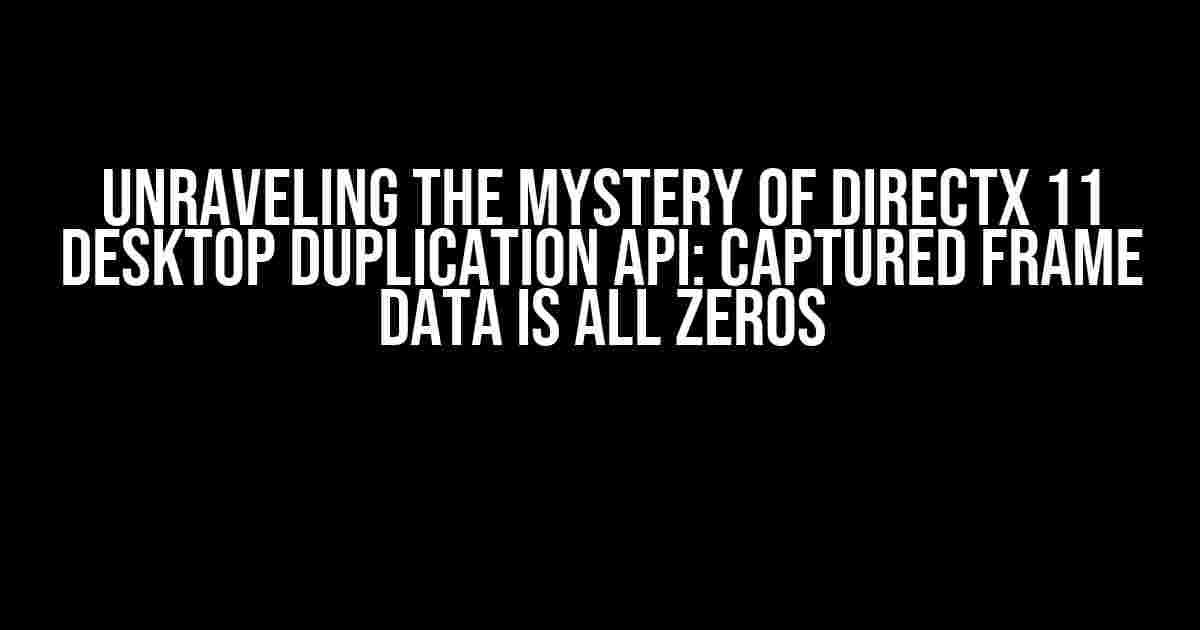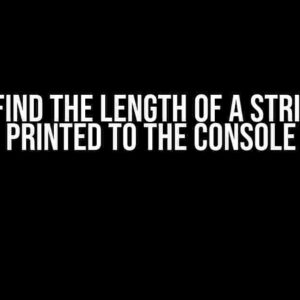Are you frustrated with capturing frame data using DirectX 11 Desktop Duplication API, only to find that the data is all zeros? You’re not alone! This article will guide you through the troubleshooting process, helping you identify and fix the common mistakes that lead to this issue.
Understanding DirectX 11 Desktop Duplication API
Before we dive into the solution, let’s take a step back and understand the basics of DirectX 11 Desktop Duplication API. This API allows developers to capture and manipulate the desktop’s frame data in real-time, enabling features like screen recording, screenshot capturing, and more.
The Desktop Duplication API provides a set of interfaces and methods to capture the desktop’s frame data, including:
- IDesktopDuplicationInterop: Provides an interface to interact with the desktop duplication process.
- IDesktopDuplicationFrameInfo: Represents a single frame of desktop data.
- IDesktopDuplicationStreamReader: Allows reading of frame data from the desktop duplication stream.
Common Causes of Captured Frame Data Being All Zeros
Now that we’ve covered the basics, let’s explore the common reasons why captured frame data might be all zeros:
- Incorrect Initialization: Failing to properly initialize the DirectX 11 Desktop Duplication API can lead to zeros in the captured frame data.
- Inadequate Buffer Size: Using a buffer that’s too small to hold the frame data can result in zeros being written to the buffer.
- Improper Buffer Allocation: Allocating memory for the buffer using the wrong method or not allocating enough memory can cause the issue.
- API Version Incompatibility: Using an incompatible version of the DirectX 11 Desktop Duplication API can lead to zeros in the captured frame data.
- Desktop Duplication Stream Issues: Problems with the desktop duplication stream, such as an empty stream or an invalid handle, can also cause the issue.
Troubleshooting and Solution
Now that we’ve identified the common causes, let’s walk through the troubleshooting process and solution:
Step 1: Verify API Initialization
First, ensure that you’ve properly initialized the DirectX 11 Desktop Duplication API by calling the Duplicator.Initialize() method.
// Create an instance of the duplicator IDesktopDuplication duplicator = new DesktopDuplication(); // Initialize the duplicator duplicator.Initialize();
Step 2: Check Buffer Size and Allocation
Next, verify that you’re using a large enough buffer to hold the frame data. You can use the IDesktopDuplicationFrameInfo.GetMetaData() method to get the required buffer size.
// Get the metadata for the current frame IDesktopDuplicationFrameInfo metadata = duplicator.GetCurrentFrameMetadata(); // Calculate the required buffer size int bufferSize = metadata.Width * metadata.Height * 4; // Allocate the buffer byte[] buffer = new byte[bufferSize];
Step 3: Verify API Version Compatibility
Make sure you’re using a compatible version of the DirectX 11 Desktop Duplication API. You can check the API version using the IDesktopDuplication.GetVersion() method.
// Get the API version
int version = duplicator.GetVersion();
// Check if the version is compatible
if (version != 0x110 || version != 0x111)
{
// Handle incompatible API version
}
Step 4: Troubleshoot Desktop Duplication Stream Issues
Finally, ensure that the desktop duplication stream is valid and not empty. You can use the IDesktopDuplication.GetOutputStream() method to get the stream.
// Get the output stream
IDesktopDuplicationStream stream = duplicator.GetOutputStream();
// Check if the stream is valid and not empty
if (stream == null || stream.Empty)
{
// Handle stream issues
}
Step 5: Capture and Verify Frame Data
After troubleshooting the common issues, you can now capture the frame data using the IDesktopDuplicationStreamReader.ReadFrame() method.
// Create a reader for the stream
IDesktopDuplicationStreamReader reader = new DesktopDuplicationStreamReader(stream);
// Read a frame from the stream
DesktopDuplicationFrame frame = reader.ReadFrame(buffer);
// Verify the frame data
if (frame.FrameData != null && frame.FrameData.Length > 0)
{
// Process the captured frame data
}
else
{
// Handle zero frame data
}
Conclusion
In conclusion, capturing frame data using DirectX 11 Desktop Duplication API can be a complex process, but identifying and fixing the common mistakes can help you overcome the issue of zeros in the captured frame data. By following the troubleshooting steps outlined in this article, you’ll be able to successfully capture and process frame data.
| API Method | Description |
|---|---|
| IDesktopDuplication.Initialize() | Initializes the desktop duplication API. |
| IDesktopDuplication.GetCurrentFrameMetadata() | Gets the metadata for the current frame. |
| IDesktopDuplication.GetVersion() | Gets the version of the desktop duplication API. |
| IDesktopDuplication.GetOutputStream() | Gets the output stream for the desktop duplication. |
| IDesktopDuplicationStreamReader.ReadFrame() | Reads a frame from the output stream. |
Remember to handle errors and exceptions properly, and always verify the captured frame data to ensure it’s valid and non-zero.
Frequently Asked Question
Stuck with DirectX 11 Desktop Duplication API and wondering why your captured frame data is all zeros? Worry no more! Here are some frequently asked questions and answers to get you back on track.
Why is my captured frame data all zeros when using DirectX 11 Desktop Duplication API?
This is usually because the DirectX 11 Desktop Duplication API requires a IDirect3DDevice or IDirect3DDeviceContext object to be created and initialized properly before attempting to capture frame data. Make sure you’ve created and initialized these objects correctly, and that your swap chain is properly configured.
Do I need to call BeginFrame and EndFrame when using DirectX 11 Desktop Duplication API?
Yes! You need to call BeginFrame and EndFrame to bracket the frame capture operation. This allows the API to properly synchronize with the desktop composition engine and capture the frame data correctly. Failing to do so can result in zeroed-out frame data.
Can I capture frame data from a specific window or region using DirectX 11 Desktop Duplication API?
Yes, you can! The DirectX 11 Desktop Duplication API allows you to specify a particular window or region to capture by setting the Output DuplicateMode to OMXMODE_WINDOW or OMXMODE_REGION, respectively. You can then use the GetFrameMoveRects and GetFrameDirtyRects methods to retrieve the updated regions and move rectangles.
Why does my capture fail when using DirectX 11 Desktop Duplication API on a remote desktop connection?
A gotcha! The DirectX 11 Desktop Duplication API doesn’t work on remote desktop connections due to the way the desktop composition engine handles remoting. You’ll need to capture the frame data locally on the machine running the remote desktop connection.
How do I handle frame data alignment when using DirectX 11 Desktop Duplication API?
The DirectX 11 Desktop Duplication API returns frame data aligned to a 4-byte boundary. Make sure to account for this alignment when processing the captured frame data to avoid any weird issues or crashes.




